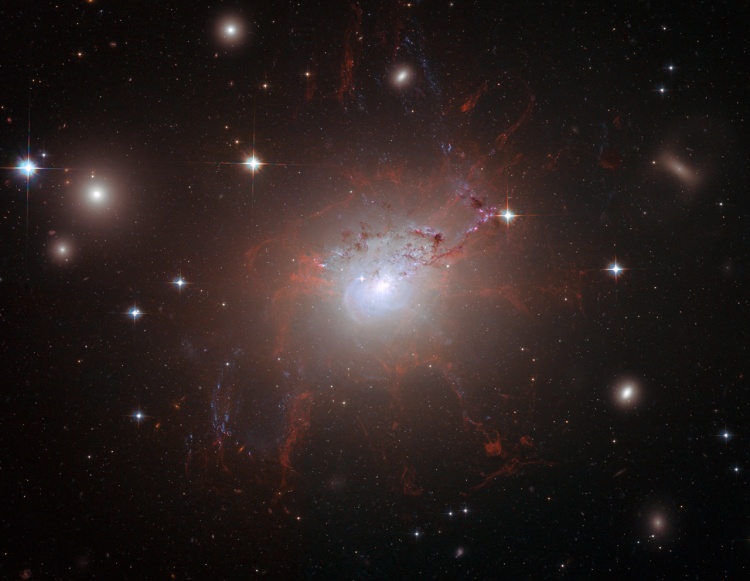
|
Credit: NASA,
ESA,
Hubble Heritage
(STScI/AURA);
A. Fabian (IoA, Cambridge U.), L. Frattare (STScI), CXC, G. Taylor, NRAO,VLA
Explanation:
Active galaxy NGC 1275
is the central, dominant member of the large and
relatively nearby
Perseus Cluster of Galaxies.
A prodigious source of
x-rays
and
radio
emission, NGC 1275 accretes
matter as entire galaxies fall into it, ultimately
feeding a supermassive black hole at the galaxy's core.
This stunning
visible
light image from the Hubble Space Telescope
shows galactic debris
and filaments of glowing gas,
some up to 20,000 light-years long.
The filaments persist in NGC 1275, even though
the turmoil of galactic collisions should destroy them.
What keeps the filaments together?
Recent work
indicates that the structures, pushed out
from the galaxy's center by the black hole's activity, are
held together by magnetic fields.
To
add x-ray data
from the Chandra Observatory and radio data from
the Very Large Array
to the Hubble image, just slide
your cursor over the picture.
In the resulting composite, x-rays highlight the
shells of hot gas
surrounding the center of the galaxy, with radio emission filling
giant bubble-shaped cavities.
Also known as Perseus A,
NGC 1275
spans over 100,000 light years and
lies about 230 million light years away.
A. Fabian (IoA, Cambridge U.), L. Frattare (STScI), CXC, G. Taylor, NRAO,VLA
|
January February March April May June July August September |
| ||||||||||||||||||||||||||||||||||||||||||||||||
NASA Web Site Statements, Warnings, and Disclaimers
NASA Official: Jay Norris. Specific rights apply.
A service of: LHEA at NASA / GSFC
& Michigan Tech. U.
Based on Astronomy Picture
Of the Day
Publications with keywords: active galaxy - NGC 1275 - Perseus cluster
Publications with words: active galaxy - NGC 1275 - Perseus cluster
See also:
